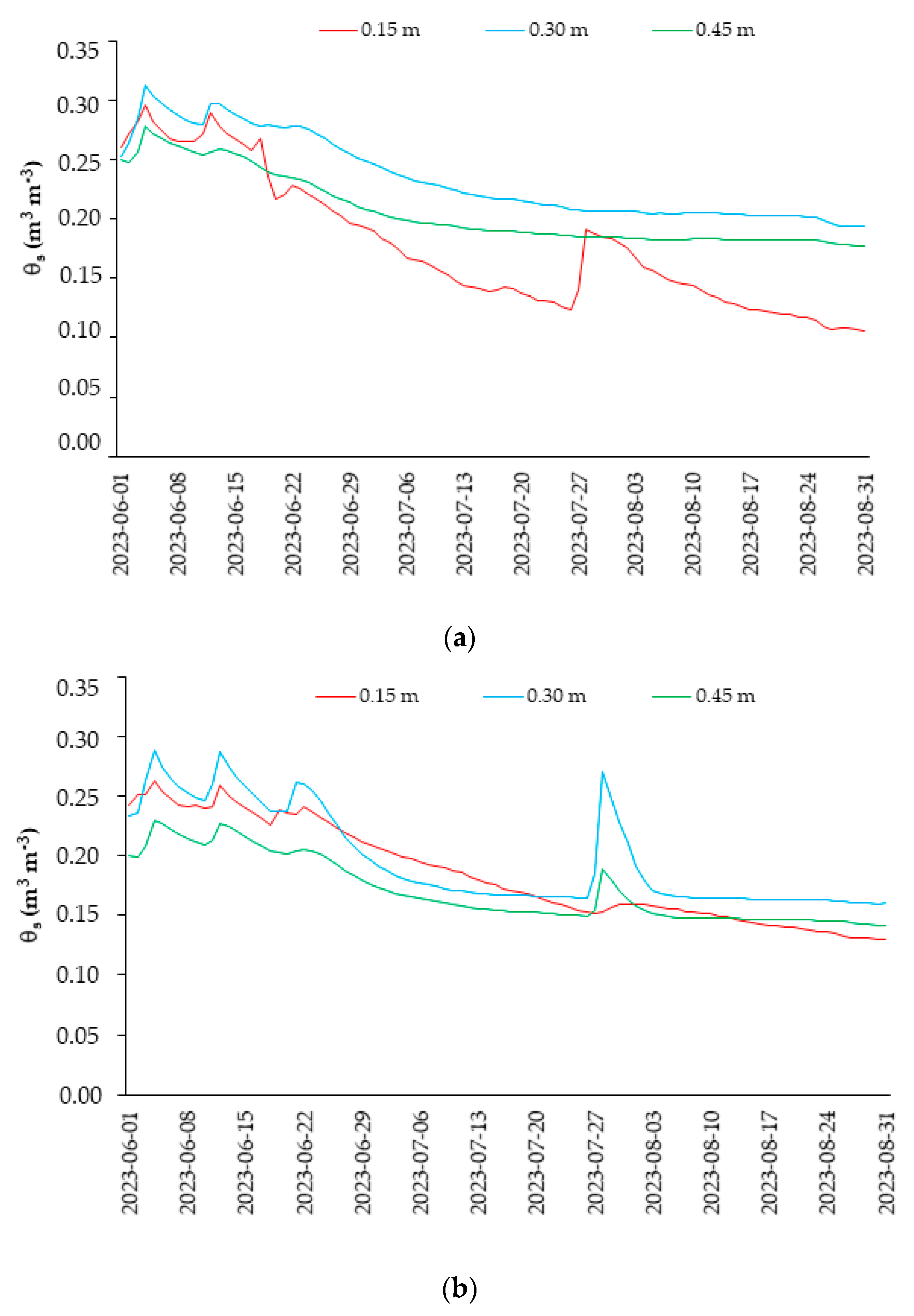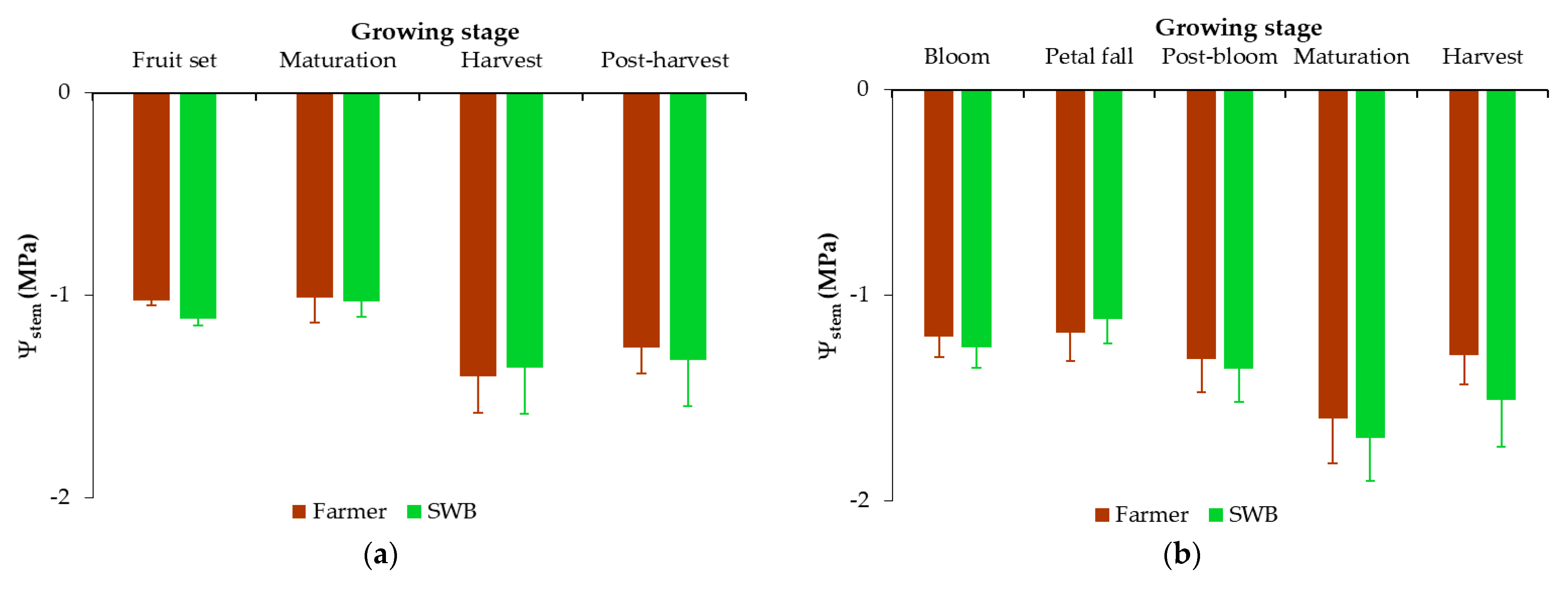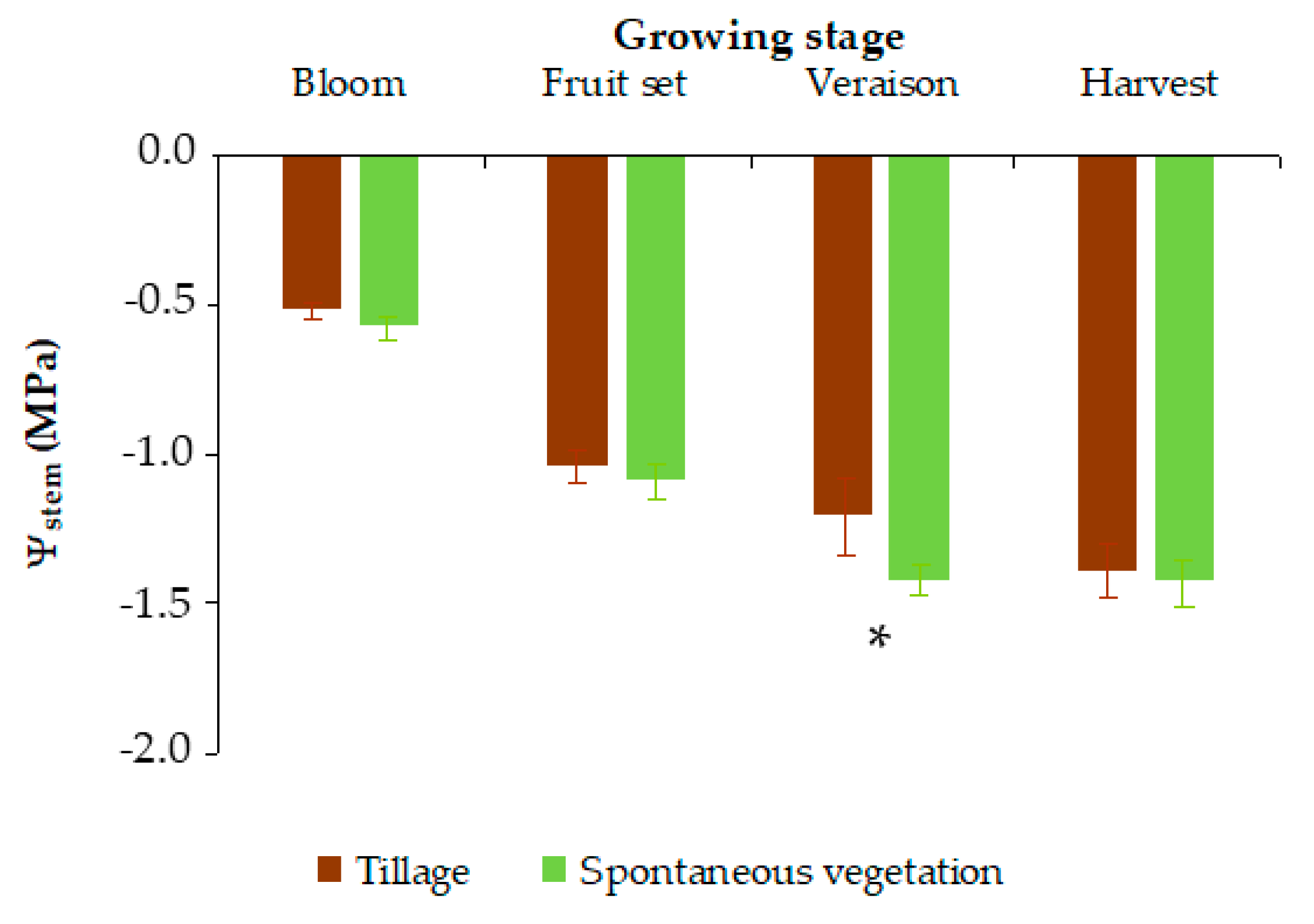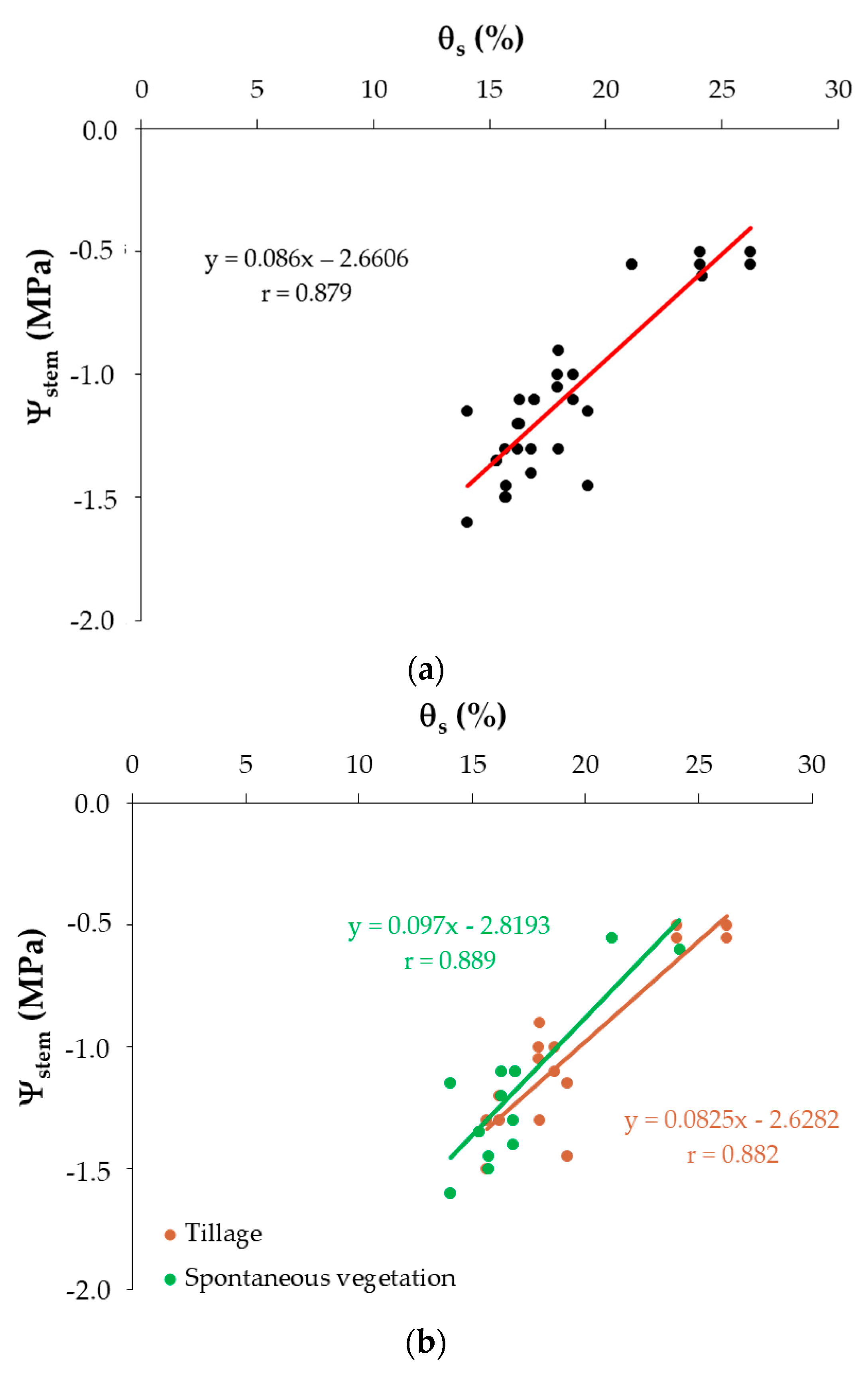Relationships Between Midday Stem Water Potential and Soil Water Content in Grapevines and Peach and Pear Trees
Abstract
1. Introduction
2. Materials and Methods
2.1. Description of the Study Sites and Experimental Treatments
- Peach orchard: located in Binaced (Huesca, Spain). It was planted with Prunus persica L. cv. “Catherine”. The orchard is drip irrigated (an emitter with a flow rate of 2 L h−1 per 0.5 m of dripline). The soil is sandy clay loam, with a basic pH and a medium organic matter content (Table 2). The climate is Mediterranean with a continental influence. In the current study, two treatments were considered: (i) irrigation according to farmer’s criteria (Farmer), and (ii) irrigation following a soil water balance (SWB), as described in Allen et al. [38], and using crop coefficients adapted to the region [12]. Weather data were collected from the nearest station (Alfántega, 13 km away from the orchard), since farmers in this area based their irrigation scheduling on the data from this station. The coefficient of uniformity of the drip system was fixed at 95%, and the effective rainfall from the previous week was subtracted.
- Pear orchard: located in Binaced (Huesca, Spain). It was planted with Pyrus communis L. cv. “Williams”. The orchard is drip irrigated (an emitter with a flow rate of 2 L h−1 per 0.5 m of dripline). The soil is clay loam, with a basic pH and a medium organic matter content (Table 2). The climate and treatments were the same as those from the previous orchard.
- Vineyard: located in Salas Bajas (Huesca, Spain). It was planted with Vitis vinifera L. cv. “Riesling” on 1103 Paulsen rootstock. The vineyard is rainfed, the vines are vertically trellised on a single cordon system, and the rows are oriented in the east–west direction. Vegetation in the inter-rows was avoided for five years after plantation, while spontaneous vegetation was allowed to grow in the inter-rows from 2017 onward (two or three mowing passes each season; plant residues remain on site). A non-grassed strip under the vines (approximately 20 cm at both sides of the vine trunk) was maintained using herbicides. The soil is sandy loam, with a basic pH and a medium organic matter content (Table 2). The climate is Mediterranean with a mountainous influence. Weather data were collected from a station located 500 m away from the vineyard. In this study, two treatments were considered: (i) a shallow tillage (10–15 cm deep) performed on 8 inter-rows using a cultivator after a rainy period at the beginning of June 2023, and (ii) green cover (resident vegetation including Amaranthus albus, Diplotaxis erucoides, Euphorbia segetalis, Medicago rigidula, Silene muscipula, and Vicia pseudocracca, among others), namely, spontaneous vegetation, was allowed to grow in the inter-row until it reached 15 cm in height, when it was mowed (twice during the growing season of 2023); no plants were allowed to grow under the vines using herbicides.
2.2. Weather Conditions and Irrigation over the Study Period
2.3. Soil Water Content and Midday Stem Water Potential Measurements
2.4. Statistical Analysis
3. Results
3.1. Evolution of Soil Water Content and Midday Stem Water Potential over the Growing Season
3.2. Relationships Between Soil Water Content and Plant Water Status
4. Discussion
5. Conclusions
Author Contributions
Funding
Data Availability Statement
Acknowledgments
Conflicts of Interest
Abbreviations
| θs | Soil water content |
| Ψstem | Midday stem water potential |
| ETo | Reference evapotranspiration |
| Tmean | Mean air temperature |
| Tmax | Maximum air temperature |
| Tmin | Minimum air temperature |
| RH | Relative humidity |
| SWB | Soil water balance |
References
- Vadez, V.; Pilloni, R.; Grondin, A.; Hajjarpoor, A.; Belhouchette, H.; Brouziyne, Y.; Chehbouni, G.; Kharrou, M.H.; Zitouna-Chebbi, R.; Mekki, I.; et al. Water use efficiency across scales: From genes to landscapes. J. Exp. Bot. 2023, 74, 4770–4788. [Google Scholar] [CrossRef] [PubMed]
- IPCC. Climate Change 2021. The Physical Science Basis. Summary for Policymakers; Intergovernmental Panel on Climate Change: Geneva, Switzerland, 2021; p. 40. [Google Scholar]
- Masia, S.; Trabucco, A.; Spano, D.; Zinder, R.L.; Sušnik, J.; Marras, S. A modeling platform for climate change impact on local and regional crop water requirements. Agric. Water Manag. 2021, 255, 107005. [Google Scholar] [CrossRef]
- Vercambre, G.; Mirás-Avalos, J.M.; Juillion, P.; Moradzadeh, M.; Plenet, D.; Valsesia, P.; Memah, M.M.; Launay, M.; Lesniak, V.; Cheviron, B.; et al. Analyzing the impacts of climate change on ecosystem services provided by apple orchards in Southeast France using a process-based model. J. Environ. Manag. 2024, 370, 122470. [Google Scholar] [CrossRef]
- Ruiz-Sanchez, M.C.; Domingo, R.; Castel, J.R. Review. Deficit irrigation in fruit trees and vines in Spain. Span. J. Agric. Res. 2010, 8, 5–20. [Google Scholar] [CrossRef]
- Mirás-Avalos, J.M.; Araujo, E.S. Optimization of vineyard water management: Challenges, strategies, and perspectives. Water 2021, 13, 746. [Google Scholar] [CrossRef]
- Marsal, J.; Mata, M.; Arbonés, A.; Rufat, J.; Girona, J. Regulated deficit irrigation and rectification of irrigation scheduling in young pear trees: An evaluation based on vegetative and productive response. Eur. J. Agron. 2002, 17, 111–122. [Google Scholar] [CrossRef]
- Gelly, M.; Recasens, I.; Mata, M.; Arbones, A.; Rufat, J.; Girona, J.; Marsal, J. Effects of water deficit during stage II of peach fruit development and postharvest on fruit quality and ethylene production. J. Hortic. Sci. Biotechnol. 2003, 78, 324–330. [Google Scholar] [CrossRef]
- van Leeuwen, C.; Trégoat, O.; Choné, X.; Bois, B.; Pernet, D.; Gaudillère, J.P. Vine water status is a key factor in grapevine ripening and vintage quality for red Bordeaux wine. How can it be assessed for vineyard management purposes? J. Int. Sci. Vigne Vin 2009, 43, 121–134. [Google Scholar] [CrossRef]
- Medrano, H.; Tomás, M.; Martorell, S.; Escalona, J.M.; Pou, A.; Fuentes, S.; Flexas, J.; Bota, J. Improving water use efficiency of vineyards in semi-arid regions. A review. Agron. Sustain. Dev. 2015, 35, 499–517. [Google Scholar] [CrossRef]
- Fereres, E.; Soriano, M.A. Deficit irrigation for reducing agricultural water use. J. Exp. Bot. 2007, 58, 147–159. [Google Scholar] [CrossRef]
- Girona, J.; Mata, M.; Arbonés, A.; Alegre, S.; Rufat, J.; Marsal, J. Peach tree response to single and combined regulated deficit irrigation regimes under shallow soils. J. Amer. Soc. Hort. Sci. 2003, 128, 432–440. [Google Scholar] [CrossRef]
- Mirás-Avalos, J.M.; Pérez-Sarmiento, F.; Alcobendas, R.; Alarcón, J.J.; Mounzer, O.; Nicolás, E. Using midday stem water potential for scheduling deficit irrigation in mid-late maturing peach trees under Mediterranean conditions. Irrig. Sci. 2016, 34, 161–173. [Google Scholar] [CrossRef]
- Blanco, V.; Kalcsits, L. Long-term validation of continuous measurements of trunk water potential and trunk diameter indicate different diurnal patterns for pear under water limitations. Agric. Water Manag. 2023, 281, 108257. [Google Scholar] [CrossRef]
- Girona, J.; Mata, M.; del Campo, J.; Arbonés, A.; Bartra, E.; Marsal, J. The use of midday leaf water potential for scheduling deficit irrigation in vineyards. Irrig. Sci. 2006, 24, 115–127. [Google Scholar] [CrossRef]
- Montanarella, L.; Panagos, P. The relevance of sustainable soil management within the European Green Deal. Land Use Pol. 2021, 100, 104950. [Google Scholar] [CrossRef]
- Celette, F.; Gaudin, R.; Gary, C. Spatial and temporal changes to the water regime of a Mediterranean vineyard due to the adoption of cover cropping. Eur. J. Agron. 2008, 29, 153–162. [Google Scholar] [CrossRef]
- Abad, J.; Hermoso de Mendoza, I.; Marín, D.; Orcaray, L.; Santesteban, L.G. Cover crops in viticulture. A systematic review (1): Implications on soil characteristics and biodiversity in vineyard. OENO One 2021, 55, 295–312. [Google Scholar] [CrossRef]
- Fernández, J.E. Plant-based methods for irrigation scheduling of woody crops. Horticulturae 2017, 3, 35. [Google Scholar] [CrossRef]
- Naor, A. Relations between leaf and stem water potentials and stomatal conductance in three field-grown woody species. J. Hortic. Sci. Biotechnol. 1998, 73, 431–436. [Google Scholar] [CrossRef]
- Shackel, K. A plant-based approach to deficit irrigation in trees and vines. HortScience 2011, 46, 173–177. [Google Scholar] [CrossRef]
- Santesteban, L.G.; Miranda, C.; Marín, D.; Sesma, B.; Intrigliolo, D.S.; Mirás-Avalos, J.M.; Escalona, J.M.; Montoro, A.; de Herralde, F.; Baeza, P.; et al. Discrimination ability of leaf and stem water potential at different times of the day through a meta-analysis in grapevine (Vitis vinifera L.). Agric. Water Manag. 2019, 221, 202–210. [Google Scholar] [CrossRef]
- Suter, B.; Triolo, R.; Pernet, D.; Dai, Z.; Van Leeuwen, C. Modeling stem water potential by separating the effects of soil water availability and climatic conditions on water status in grapevine (Vitis vinifera L.). Front. Plant Sci. 2019, 10, 1485. [Google Scholar] [CrossRef] [PubMed]
- Choné, X.; Van Leeuwen, C.; Dubourdieu, D.; Gaudillère, J.P. Stem water potential is a sensitive indicator of grapevine water status. Ann. Bot. 2001, 87, 477–483. [Google Scholar] [CrossRef]
- Conesa, M.R.; Conejero, W.; Vera, J.; Ramírez-Cuesta, J.M.; Ruiz-Sánchez, M.C. Terrestrial and remote indexes to assess moderate deficit irrigation in early-maturing nectarine trees. Agronomy 2019, 9, 630. [Google Scholar] [CrossRef]
- Zinkernagel, J.; Maestre-Valero, J.F.; Seresti, S.Y.; Intrigliolo, D.S. New technologies and practical approaches to improve irrigation management of open field vegetable crops. Agric. Water Manag. 2020, 242, 106404. [Google Scholar] [CrossRef]
- Rienth, M.; Scholasch, T. State-of-the-art of tools and methods to assess vine water status. OENO One 2019, 53, 619–637. [Google Scholar] [CrossRef]
- Vanella, D.; Ramírez-Cuesta, J.M.; Sacco, A.; Longo-Minnolo, G.; Cirelli, G.L.; Consoli, S. Electrical resistivity imaging for monitoring soil water motion patterns under different drip irrigation scenarios. Irrig. Sci. 2021, 39, 145–157. [Google Scholar] [CrossRef]
- Raffelli, G.; Previati, M.; Canone, D.; Gisolo, D.; Bevilacqua, I.; Capello, G.; Biddoccu, M.; Cavallo, E.; Deiano, R.; Cassiani, G.; et al. Local- and plot-scale measurements of soil moisture: Time and spatially resolved field techniques in plain, hill and mountain sites. Water 2017, 9, 706. [Google Scholar] [CrossRef]
- Williams, L.E.; Araujo, F.J. Correlations among predawn leaf, midday leaf, and midday stem water potential and their correlations with other measures of soil and plant water status in Vitis vinifera. J. Am. Soc. Hortic. Sci. 2002, 127, 448–454. [Google Scholar] [CrossRef]
- Williams, L.E.; Trout, T.J. Relationships among vine and soil based measures of water status in a Thompson Seedless vineyard in response to high frequency drip irrigation. Am. J. Enol. Vitic. 2005, 56, 357–366. [Google Scholar] [CrossRef]
- Martínez-Gimeno, M.A.; Jiménez-Bello, M.A.; Lidón, A.; Manzano, J.; Badal, E.; Pérez-Pérez, J.G.; Bonet, L.; Intrigliolo, D.S.; Esteban, A. Mandarin irrigation scheduling by means of frequency domain reflectometry soil moisture monitoring. Agric. Water Manag. 2020, 235, 106151. [Google Scholar] [CrossRef]
- Soulis, K.X.; Elmaloglou, S.; Dercas, N. Investigating the effects of soil moisture sensors positioning and accuracy on soil moisture-based drip irrigation scheduling systems. Agric. Water Manag. 2015, 148, 258–268. [Google Scholar] [CrossRef]
- Ferrarezi, R.S.; Nogueira, T.A.R.; Zepeda, S.G.C. Performance of soil moisture sensors in Florida sandy soils. Water 2020, 12, 358. [Google Scholar] [CrossRef]
- Goldhamer, D.A.; Fereres, E.; Mata, M.; Girona, J.; Cohen, M. Sensitivity of continuous and discrete plant and soil water status monitoring in peach trees subjected to deficit irrigation. J. Amer. Soc. Hort. Sci. 1999, 124, 437–444. [Google Scholar] [CrossRef]
- Intrigliolo, D.S.; Castel, J.R. Vine and soil-based measures of water status in a Tempranillo vineyard. Vitis 2006, 45, 157–163. [Google Scholar] [CrossRef]
- Martínez, E.M.; Rey, B.J.; Fandiño, M.; Cancela, J.J. Impact of water stress and nutrition on Vitis vinifera cv. ‘Albariño’: Soil-plant water relationships, cumulative effects and productivity. Span. J. Agric. Res. 2016, 14, e1202. [Google Scholar] [CrossRef]
- Allen, R.G.; Pereira, L.S.; Raes, D.; Smith, M. Crop Evapotranspiration–Guidelines for Computing Crop Water Requirements; Irrigation and Drainage Nº 56; FAO: Rome, Italy, 1998; p. 300. [Google Scholar]
- Levin, A.D. Re-evaluating pressure chamber methods of water status determination in field-grown grapevine (Vitis spp.). Agric. Water Manag. 2019, 221, 422–429. [Google Scholar] [CrossRef]
- R Core Team. R: A Language and Environment for Statistical Computing; R Foundation for Statistical Computing: Vienna, Austria, 2023; Available online: https://www.R-project.org/ (accessed on 14 October 2024).
- Abrisqueta, I.; Conejero, W.; Valdés-Vela, M.; Vera, J.; Ortuño, M.F.; Ruiz-Sánchez, M.C. Stem water potential estimation of drip-irrigated early-maturing peach trees under Mediterranean conditions. Comput. Electron. Agric. 2015, 114, 7–13. [Google Scholar] [CrossRef]
- Blanco, V.; Willsea, N.; Campbell, T.; Howe, O.; Kalcsits, L. Combining thermal imaging and soil water content sensors to assess tree water status in pear trees. Front. Plant Sci. 2023, 14, 1197437. [Google Scholar] [CrossRef]
- Morlat, R.; Jacquet, A. Grapevine root system and soil characteristics in a vineyard maintained long-term with or without interrow sward. Am. J. Enol. Vitic. 2003, 54, 1–7. [Google Scholar] [CrossRef]
- Monteiro, A.; Lopes, C.M. Influence of cover crop on water use and performance of vineyard in Mediterranean Portugal. Agric. Ecosyst. Environ. 2007, 121, 336–342. [Google Scholar] [CrossRef]






| Characteristic | Peach Orchard | Pear Orchard | Vineyard |
|---|---|---|---|
| Municipality | Binaced | Binaced | Salas Bajas |
| Geographical coordinates | 41°49′26.17″ N 0°13′23.72″ E | 41°49′59.8″ N 0°12′7.86″ E | 42°5′33.5″ N 0°5′8.9″ E |
| Elevation (m) | 290 | 269 | 440 |
| Surface (ha) | 2.14 | 0.98 | 1.88 |
| Year of plantation | 2018 | 2014 | 2013 |
| Plant spacings (m) | 5 × 3 | 4 × 2 | 2.8 × 0.9 |
| Plant density (trees ha−1) | 667 | 1250 | 3968 |
| Irrigation | Yes | Yes | No |
| Average mean temperature (°C) | 14.5 | 14.5 | 14.3 |
| Annual rainfall (mm) | 398 | 398 | 462 |
| Annual ETo (mm) | 1130 | 1130 | 1205 |
| Orchard | Sand | Silt | Clay | OM | FC | PWP | Available Water | pH |
|---|---|---|---|---|---|---|---|---|
| % | -- | |||||||
| Peach | 51.4 | 27.3 | 21.3 | 1.70 | 24.3 | 16.0 | 8.3 | 8.47 |
| Pear | 31.0 | 31.0 | 38.0 | 1.55 | 28.6 | 21.3 | 7.4 | 8.42 |
| Vineyard | 62.9 | 23.2 | 13.9 | 1.97 | 22.3 | 12.3 | 9.9 | 8.04 |
| Month | Tmax | Tmin | Tmean | RH | Rainfall | ETo |
|---|---|---|---|---|---|---|
| °C | % | mm | ||||
| “Alfántega” weather station (peach and pear orchards) | ||||||
| May | 30.1 | 4.4 | 17.7 | 65.4 | 58.6 | 140.9 |
| June | 38.4 | 11.5 | 22.5 | 75.9 | 91.2 | 138.8 |
| July | 42.9 | 12.5 | 26.0 | 66.5 | 5.1 | 169.1 |
| August | 40.8 | 10.1 | 25.7 | 54.8 | 1.0 | 170.3 |
| “Salas Bajas” weather station (vineyard) | ||||||
| May | 28.4 | 4.5 | 17.4 | 34.8 | 70.4 | 162.3 |
| June | 35.6 | 11.2 | 21.6 | 48.0 | 129.8 | 156.7 |
| July | 40.4 | 12.5 | 25.8 | 38.7 | 18.0 | 209.3 |
| August | 39.6 | 10.7 | 26.2 | 29.6 | 3.0 | 217.9 |
| Orchard | θs (m3 m−3) | Ψstem (MPa) | ||
|---|---|---|---|---|
| 0.15 m | 0.30 m | 0.45 m | ||
| Peach | 0.09 | 0.09 | 0.10 | −1.21 |
| Pear | 0.13 | 0.14 | 0.15 | −1.39 |
| Vineyard | 0.18 | 0.20 | 0.20 | −1.08 |
| Data Pairs | n | Regression Equation | Pearson’s r Coefficient | p-Value |
|---|---|---|---|---|
| Peach | ||||
| Ψstem vs. θs 0.15 m | 8 | Ψstem = 0.109 θs − 2.406 | 0.866 | 0.0034 |
| Ψstem vs. θs 0.30 m | 8 | Ψstem = 0.122 θs − 2.578 | 0.815 | 0.0084 |
| Ψstem vs. θs 0.45 m | 8 | Ψstem = 0.112 θs − 2.619 | 0.754 | 0.0186 |
| Ψstem vs. θs 0.15–0.45 m | 8 | Ψstem = 0.119 θs − 2.584 | 0.834 | 0.0062 |
| Pear | ||||
| Ψstem vs. θs 0.15 m | 10 | Ψstem = 0.066 θs − 2.200 | 0.551 | 0.057 |
| Ψstem vs. θs 0.30 m | 10 | Ψstem = 0.197 θs − 4.218 | 0.531 | 0.066 |
| Ψstem vs. θs 0.45 m | 10 | Ψstem = 0.606 θs − 10.325 | 0.561 | 0.053 |
| Ψstem vs. θs 0.15–0.45 m | 10 | Ψstem = 0.141 θs − 3.338 | 0.558 | 0.054 |
| Grapevine | ||||
| Ψstem vs. θs 0.15 m | 32 | Ψstem = 0.055 θs − 2.003 | 0.777 | <0.0001 |
| Ψstem vs. θs 0.30 m | 32 | Ψstem = 0.037 θs − 1.765 | 0.555 | 0.0006 |
| Ψstem vs. θs 0.45 m | 32 | Ψstem = 0.121 θs − 3.441 | 0.904 | <0.0001 |
| Ψstem vs. θs 0.15–0.45 m | 32 | Ψstem = 0.086 θs − 2.661 | 0.765 | <0.0001 |
Disclaimer/Publisher’s Note: The statements, opinions and data contained in all publications are solely those of the individual author(s) and contributor(s) and not of MDPI and/or the editor(s). MDPI and/or the editor(s) disclaim responsibility for any injury to people or property resulting from any ideas, methods, instructions or products referred to in the content. |
© 2025 by the authors. Licensee MDPI, Basel, Switzerland. This article is an open access article distributed under the terms and conditions of the Creative Commons Attribution (CC BY) license (https://creativecommons.org/licenses/by/4.0/).
Share and Cite
Mirás-Avalos, J.M.; Araujo, E.S. Relationships Between Midday Stem Water Potential and Soil Water Content in Grapevines and Peach and Pear Trees. Agronomy 2025, 15, 1257. https://doi.org/10.3390/agronomy15051257
Mirás-Avalos JM, Araujo ES. Relationships Between Midday Stem Water Potential and Soil Water Content in Grapevines and Peach and Pear Trees. Agronomy. 2025; 15(5):1257. https://doi.org/10.3390/agronomy15051257
Chicago/Turabian StyleMirás-Avalos, José Manuel, and Emily Silva Araujo. 2025. "Relationships Between Midday Stem Water Potential and Soil Water Content in Grapevines and Peach and Pear Trees" Agronomy 15, no. 5: 1257. https://doi.org/10.3390/agronomy15051257
APA StyleMirás-Avalos, J. M., & Araujo, E. S. (2025). Relationships Between Midday Stem Water Potential and Soil Water Content in Grapevines and Peach and Pear Trees. Agronomy, 15(5), 1257. https://doi.org/10.3390/agronomy15051257









